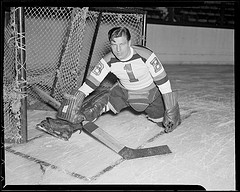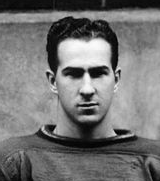
The Boston Bruins are a professional ice hockey team based in Boston. The Bruins compete in the National Hockey League (NHL) as a member of the Atlantic Division in the Eastern Conference. The team has been in existence since 1924, making them the third-oldest active team in the NHL, and the oldest in the United States.

Harry James Sinden is a Canadian former ice hockey player, coach, and executive. He served as a coach, general manager, and team president for the Boston Bruins of the National Hockey League (NHL), and was the coach of Team Canada during the 1972 Summit Series. He is a member of the Hockey Hall of Fame in the builders category. He was inducted into the IIHF Hall of Fame in its inaugural class of 1997.

Arthur Howey Ross was a Canadian professional ice hockey player and executive from 1905 until 1954. Regarded as one of the best defenders of his era by his peers, he was one of the first to skate with the puck up the ice rather than pass it to a forward. He was on Stanley Cup championship teams twice in a playing career that lasted thirteen seasons; in January 1907 with the Kenora Thistles and 1908 with the Montreal Wanderers. Like other players of the time, Ross played for several different teams and leagues, and is noted for his time with the Wanderers while they were members of the National Hockey Association (NHA) and its successor, the National Hockey League (NHL). In 1911, he led one of the first organized player strikes over increased pay. When the Wanderers' home arena burned down in January 1918, the team ceased operations and Ross retired as a player.

Robert Theodore Bauer was a Canadian professional ice hockey right winger who played 10 seasons in the National Hockey League (NHL) for the Boston Bruins. He was a member of the famed "Kraut Line" with teammates Milt Schmidt and Woody Dumart. The trio led the Bruins to two Stanley Cup championships and became the first line to finish first, second and third in NHL scoring, in 1939–40. Bauer was named to the All-Star team four times and was a three-time winner of the Lady Byng Trophy, awarded for gentlemanly conduct combined with a high calibre of play. He recorded only 36 penalties in minutes in 327 games.

Francis Charles "Mr. Zero" Brimsek was an American professional ice hockey goaltender who played ten seasons in the National Hockey League (NHL) for the Boston Bruins and Chicago Black Hawks. He won the Calder Memorial Trophy as a rookie, and the Vezina Trophy twice, and he was named to the NHL All-Star team eight times. He was also a member of two Stanley Cup championships. At the time of his retirement in 1950, he held the records for most wins and shutouts recorded by an American goaltender; these records stood for 54 years and 61 years respectively. In 1966, he was inducted into the Hockey Hall of Fame, the first American goalie to be inducted; and in 1973, he was part of the inaugural class of the United States Hockey Hall of Fame. In 1998, Brimsek was ranked number 67 on The Hockey News' list of the 100 Greatest Hockey Players, the highest ranked American goaltender.

William Mailes "Cowboy" Cowley was a Canadian professional ice hockey centre who played 13 seasons in the National Hockey League for the St. Louis Eagles and Boston Bruins. Described as the Wayne Gretzky of his era, Cowley twice won the Hart Memorial Trophy as the NHL's MVP, and is widely regarded as one of the best playmakers in hockey history.

Woodrow Wilson Clarence Dumart was a Canadian professional ice hockey player, most notably for the Boston Bruins of the National Hockey League. He is an Honoured Member of the Hockey Hall of Fame. Dumart's uncle Ezra Dumart was also a professional ice hockey player.
The 1939–40 NHL season was the 23rd season for the National Hockey League. Of the league's seven teams, the Boston Bruins were the best in the 48-game regular season, but the Stanley Cup winners were the New York Rangers, who defeated the Toronto Maple Leafs in the best-of-seven final series 4–2 for their third Stanley Cup in 14 seasons of existence. It would be another 54 years before their fourth.
The 1944–45 NHL season was the 28th season of the National Hockey League. Six teams each played 50 games. The Toronto Maple Leafs won the Stanley Cup in seven games versus the Detroit Red Wings.

The Kraut line were a trio of Boston Bruins players who played on the same NHL forward line: center Milt Schmidt, left wing Woody Dumart, and right wing Bobby Bauer. The name was devised by Albert Leduc, a player for the Montreal Canadiens, while the trio were playing for a Boston farm club in 1936; originally "The Sauerkraut Line", the nickname was later shortened to "The Kraut Line". The name referenced the German descent of the three players, all of whom grew up in Kitchener, Ontario, where they previously played for the Kitchener Greenshirts. The trio played almost 1,900 NHL games with the Bruins, but put their careers on hold during World War II to serve in the Royal Canadian Air Force. They were one of the most dominant lines of any era, having finished first, second, and third in scoring during the 1939-1940 season, a feat repeated only twice; by the 1944–45 Punch line of the Montreal Canadiens, and the 1949–50 Production Line of the Detroit Red Wings. All three members of the Kraut line are inductees in the Hockey Hall of Fame.

Herbert James Cain was a Canadian professional ice hockey left winger who played 13 seasons in the National Hockey League (NHL) for the Montreal Maroons, Montreal Canadiens, and Boston Bruins between 1933 and 1946.
The Kitchener Greenshirts name has been used by five separate ice hockey teams playing in Kitchener, Ontario, Canada. These include one 'Senior A' level hockey team, two 'Junior A' level teams, and two 'Junior B' level teams. The name has also been used for a team in the Ontario Minor Hockey Association (OMHA).
Donald Calvin Gallinger was a Canadian ice hockey player who played 222 games in the National Hockey League with the Boston Bruins between 1942 and 1948. Born in Port Colborne, Gallinger was one of the league's youngest players when he broke into the NHL, playing on the "Sprout Line" of Boston with Bill Shill and Bep Guidolin. Gallinger's career was cut short, when in 1948 Gallinger and former team-mate Billy Taylor were discovered gambling on their own teams and banned for life by the NHL. They were reinstated in 1970 and these are the longest suspensions in NHL history. Prior to the suspension, Gallinger had established himself an effective offensive NHL player and, as an excellent multi-sport athlete, had even been sought after to play professional baseball.
The 1939 Stanley Cup Finals was contested by the Boston Bruins and the Toronto Maple Leafs. It was Boston's first appearance in the Finals since 1930; Toronto had appeared in the previous year. Boston won the series 4–1 to win their second Stanley Cup. This was the first Stanley Cup Finals to be contested as a best-of-seven series, and every subsequent Stanley Cup Finals have been contested as such.
The 1941 Stanley Cup Finals was a best-of-seven series between the Boston Bruins and the Detroit Red Wings. Boston would win the series 4–0 to win their third Stanley Cup.
The 1940–41 Boston Bruins season was the Bruins' 17th season in the National Hockey League, and they were coming off of a successful season in 1939–40, leading the NHL in points for the third season in a row, as they finished with a 31–12–5 record, accumulating 67 points. However, the Bruins lost to the New York Rangers in the NHL semifinals, ending their chances for a second-straight Stanley Cup. This year, the Bruins repeated as regular season champions and returned to the Stanley Cup Finals, defeating the Detroit Red Wings four games to none to win the organization's third Stanley Cup.
The 1941–42 Boston Bruins season, was the team's 18th season. They placed third in the National Hockey League.
The 1945–46 Boston Bruins season was the Boston Bruins 22nd season of operation in the National Hockey League. The Bruins made it to the 1946 Stanley Cup Finals only to lose to the rival Montreal Canadiens four games to one.
The 1951–52 Boston Bruins season was the Bruins' 28th season in the NHL.
The history of the Boston Bruins professional ice hockey team dates back to 1924, making them the third-oldest active team in the National Hockey League (NHL), and the oldest surviving professional hockey franchise in the United States.











